Critical mass seems to be approaching for a Blurb book of ice photographs, but the conceptual work remains to be done on text and sequence. Here’s a bunch of candidates for inclusion:
Monthly Archives: February 2018
the drama continued
Each time I revisit Drift Inn beach I search for Bodhidharma (see the last post if this makes no sense whatever), but he continues to be Elsewhere. Yesterday I found and retrieved a faux-Bodhidharma whose manifestation taunted me:
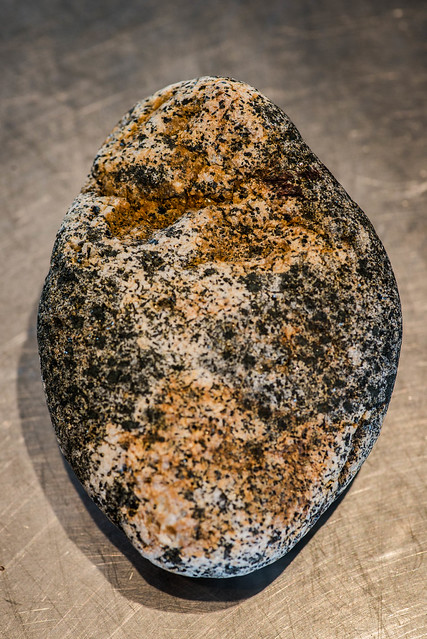
On the other side there’s even a face with a goofy grin, as if to say: fooled you!
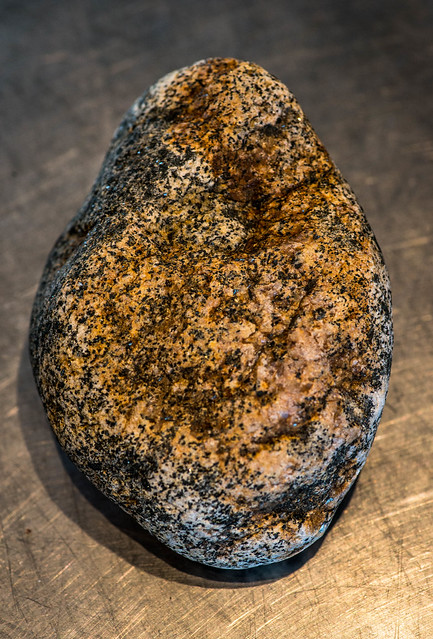
a lesson learned
The Just A Rock book is beginning to come together, slowly, and is of course accompanied by discoveries and diversions of many flavors. I’ve been photographing at Drift Inn almost daily for the last 6 weeks or so, and each time I discover new rocks and often enough re-photograph ones I’ve already collected. A few days ago I was paying more attention to smaller rocks, those that fit in the hand and are rolled back and forth by the tide. One that I picked up seemed especially characterful, so I set it on a flat granite surface and photographed it:
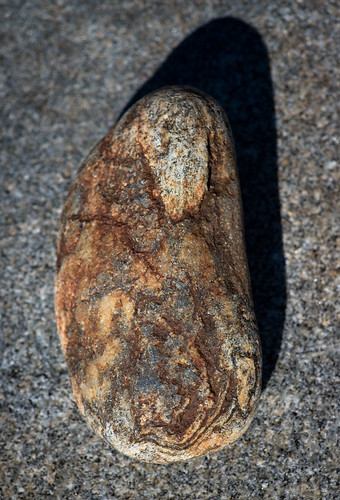
…and tossed it back onto the rocky beach.
It wasn’t until I was processing the image that I noticed that it was a portrait, and my first thought was “Zen Patriarch” since it reminded me of Japanese paintings I’d seen of those worthies. I wasn’t immediately sure which Patriarch, but put that question aside to explore later.
I’ve lately been reading The Gateless Gate: the classic book of Zen koans, and yesterday morning arrived at Number 4:
The commentary explains that the koan has to do with the vexed and fundamental question of the distinction between the essential and the phenomenal, which bears directly upon what I’ve been trying to write about in the case of rocks [relevant to the distinction between rock as an abstract and a rock as something with character and personality]. The “western barbarian” in the koan is often personified as Bodhidharma, the First Zen Patriarch, who was indeed an Indian monk who went to China in the 6th century:
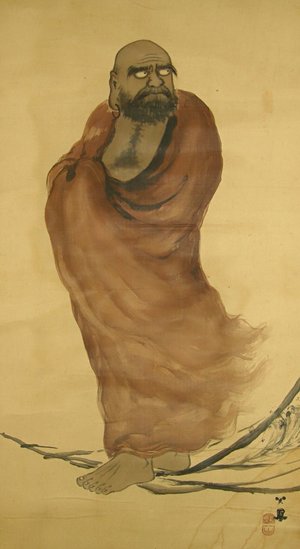
So I realized that I wanted to find that rock with Bodhidharma on it; I wanted to possess it (I do have a modest collection of especially evocative rocks…). I went back to Drift Inn to try to find it again. And didn’t. And went back twice more, trying to reconstruct where I might have tossed it. No Bodhidharma.
A haiku came to me, as haikus are wont to do:
among the ten thousand rocks
alas, he’s moved on
The quick-witted will note that my Drift Inn beach Bodhidharma has no [evident, phenomenal] beard. Teisho’s commentary on the koan includes this:
Pictures of Bodhidharma are well known, and not only does he always have a beard but a very thick beard indeed! Wakuan was well aware of this. Why then does he say that Bodhidharma has no beard?
Everything has two aspects, phenomenal and essential. The phenomenal Bodhidharma has a beard, but the essential Bodhidharma has no beard. To realize this, you must grasp by experience the essential nature of Bodhidharma.
…
The essential nature [of anything] cannot be destroyed, even by karmic fire. If the whole universe were to be completely destroyed, the essential nature would continue to exist because it is empty. It is nonsubstantial. It cannot be seen with the eyes, heard with the ears, or touched with the hands. No one can identify the spot where it is.
So here’s what I was writing about rock before all the above happened:
The essence of rock is mineral, molecular, elemental, time-encapsulating, entropic [in the process of returning to its chemical origins], crystalline, cooled to a solid phase of a material derived from and still encapsulating its liquid phase.
The essence of a rock, such as one might hold or photograph, is revealed via the phenomenal engagement with a mind: the mind discerns (makes, constructs) form. The mind of a geologist attaches labels and associations and temporal structure; the mind of a wall builder sees mass and shape and fit; the mind of a sculptor may see the form that dwells within; the mind of an artist abstracts and transforms the visual appearance of the rock…
So you can see why the progress on Just A Rock is slow…
One of today’s rock creatures:
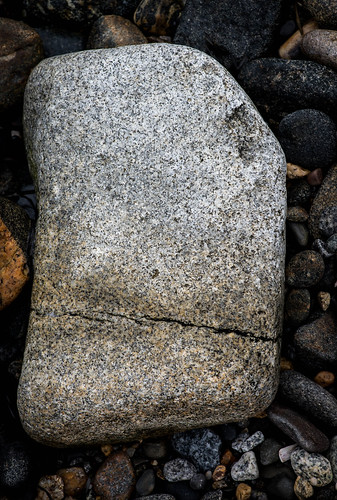
another case of the Ephemeral
I continue to explore the mysteries of connotation that accompany the images in my Flickr photostream, wondering what inspires or provokes their composition and capture. Often it’s only during the processing phase that I recognize what a photograph contains, or means, or alludes to. This one is an example of an unsolved problem:
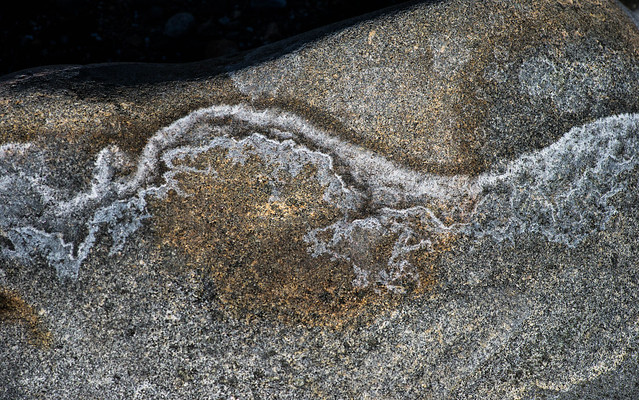
This is simply a salt deposit left on a rock by the receding tide, a phenomenon that seems to happen when the air temperature is well below freezing. The next tide will obliterate the pattern, so its life is only a few hours. The complexity seems to demand an interpretation, an effort to parse the pattern for some sort of figurative meaning. Thusfar I haven’t discerned any faces or other recognizable forms beyond the sinusoidal curve that’s uppermost. There’s something evocative of Japanese painting in the deposit below the thicker curve, but overall I have no better option than to label the image as ‘abstract’. So what drew me to it? Why did I capture it? There’s something elegant in the curves and textures, but beyond that I can’t reconstruct my specific motivation or thought process. It just seemed to ask to be harvested and saved from oblivion.
Does it help at all to mirror the image?

Ah. Now I see something analogous to the figure seen on so many New England gravestones, the symmetrical wings around the death’s head:
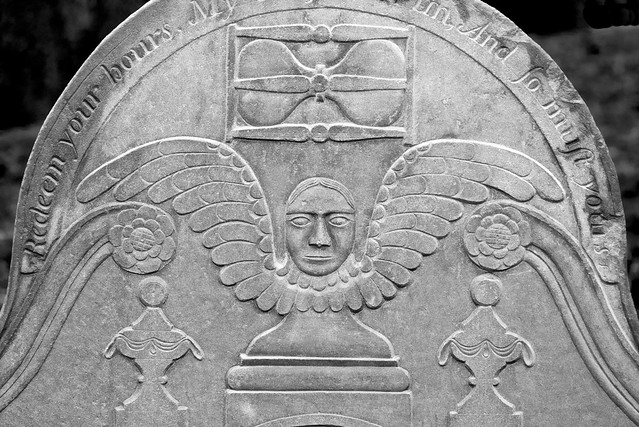
But this symmetrical extension doesn’t solve any of the original problems of interpretation, or get me any further along in the quest to comprehend the genesis of the image. The original photograph is a satisfying composition, slightly ambiguous in scale, a small detail in the grand complexity of a particular landscape in space and time, and perhaps makes sense only in the context of a gatheration of photographs of salt deposits on rocks.